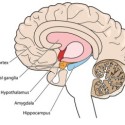This is the second of the series where we look under the bonnet of the brain to see how different areas of the brain are involved in the formation and maintenance of different habitual responses.
Our aim is to use this knowledge to make or change these connections when we need to do so.
Aside from its relationship to movement disorders such as Parkinson’s disease little was known about the Basal Ganglia and the role they played in habit formation until the late 80’s.
Our subsequent knowledge has come from observational research on patients with brain damage, functional MRI and other imaging techniques in both healthy and other groups of volunteers, and micro electrical research using animals such as rats.
Charles Duhigg, in his book Habit[1], summarizes the story of Eugene Panly, who after an episode of viral encephalitis was found to have almost surgically precise damage to the Medial Temporal Lobes on either side of his brain. These two 5cm sized areas house important areas for memory including the Hippocampus.
The Hippocampus plays a role in remembering the content and context of an experience, for example what we see, hear, feel etc. It is key to remembering specific events (episodes) and facts (semantic memory). It is also important for motivation and choosing to delay choices, either because of previous learning, and/or the ability to imagine potential outcomes, good or bad.
Although Eugene Panly lost his ability to remember events or what he had been told or had said a few minutes previously, he retained many of the ‘habits’ he had learnt in his younger days. He remained personable, polite and conversationally competent, albeit he may repeat that same conversation a few minutes later.
More importantly, with repetition, he was able to learn new habits and routines without understanding how or why. It became clear that his intact Basal Ganglia could store new information even though it didn’t involve the Hippocampal part of his memory ‘bank’.
The Basal Ganglia, golf-ball sized areas situated deep within either side of the brain, include the Caudate and Putamen, or collectively the Ventral Striatum, which seem to be particularly important for the formation and maintenance of habits.
At the base of the Caudate and Putamen is the Nucleus Accumbens, often considered to be the third division of the Striatum.
The Basal Ganglia and their connections with the Limbic System, including the Amygdala and the brain stem, are where we integrate emotional experience into our perception which can be an important element in habit formation.
After all we all know how much easier it is learn and repeat something we find enjoyable or pleasurable as against something that is a chore or involves hard work!
Physical movement is associated with Basal Ganglia activity particularly if it is pleasurable, rewarding or fulfilling. Impairment/damage in this area is responsible for the movement disorder in Parkinson’s disease.
The pleasure pathway and its role in habit learning.
The Nucleus Accumbens and its connections with the Prefrontal Cortex (PFC) and the Ventral Tectal Area in the midbrain make up what has been called the ‘Pleasure Pathway’. These areas and circuits are involved in the control of emotion, memory and gratification.
Activation of these areas, for example in response to pleasurable food or alcohol, produces intrinsic pleasure which reinforces the experience. We mention this again when we discuss the role of Dopamine in reward and reinforcement.
Although these responses are ordinarily controlled by our PFC, repetitive use of the Pleasure Pathway may override this function.
Indeed it has been shown that frequent reward seeking behavior can lead to functional changes in brain circuitry which can influence how we react on a day-to-day basis.
Learnt habitual responses can become automatic unconscious reactions to various triggers.
Experiments with the rats using micro electrical monitoring of brain activity during maze orientated tasks, showed that as they repeated the tasks, the learnt process became ‘chunked’ and automatic.
Chunking is also how we learn to remember bits of information such as PIN or telephone numbers. When habit chunking has occurred electrical activity in the decision making or ‘thinking’ areas in the PFC decreases. When this happens a learnt pattern of behavior can occur in response to a trigger without conscious involvement.
A summary of how the Basal Ganglia is involved in habitual responses:
- They house our habitual routines and guide our responses.
- Connections in the habit circuits in the Basal Ganglia are faster than those in the PFC often responding to cues or triggers ‘involuntarily’ and automatically.
- This is also where we respond intuitively e.g. “gut reactions”
- Given its connections with the Limbic (“hot”) system, this is where impulsive and other behavioral responses are often driven by emotion.
- This area is important in making changes to habitual responses and making them stick.
Key message:
Although it is possible to learn new habits without making conscious choices or remembering how, it should be easier to learn a more useful habit when you ready to do so. ‘Readiness’ is part of the preparation for change which we will refer to many times in the H4H process.
[1] Charles Duhigg The power of Habit: Why we do what we do, and How to change.


Sorry, comments are closed for this post.